Tutorial: Maximize Brightness and Contrast in Apple Final Cut Pro X
The histogram and the waveform in Apple Final Cut Pro X are effective, easy-to-master tools that provide the clear input you need to diagnose and fix the contrast issues in your video simply and intelligently. In this video tutorial, video editing and encoding expert Jan Ozer explains how they work.
In this tutorial you'll learn how to maximize the brightness and contrast of your video in Apple Final Cut Pro X. I'm working with video I shot recently of local congressional candidate Anthony Flaccavento. I shot the speech indoors under fluorescent lights. Although the color balance is fine, it lacks contrast and it's pretty noisy, as you can see in the video above. We'll deal with the noise issue in a later tutorial.
Using the Luma Histogram for Brightness
One definition of contrast is the differential between the brightest and darkest pixels in the image. And you can see that most clearly in the histogram scope. We'll begin by opening that. To do so in FCP X, choose Window > Show Video Scopes (Figure 1, below).
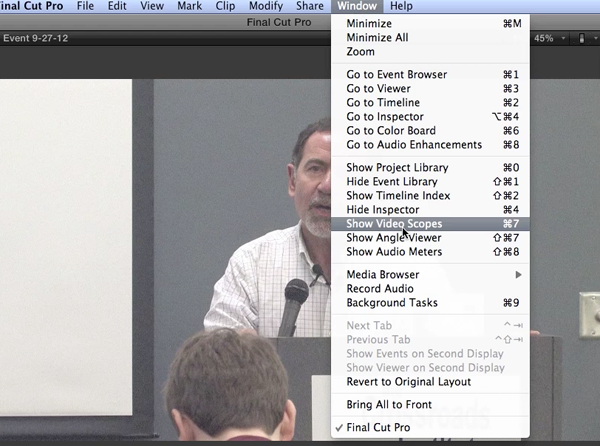
Figure 2 (below) shows that we've set the histogram to present the Luma channel, which is the measure of brightness.
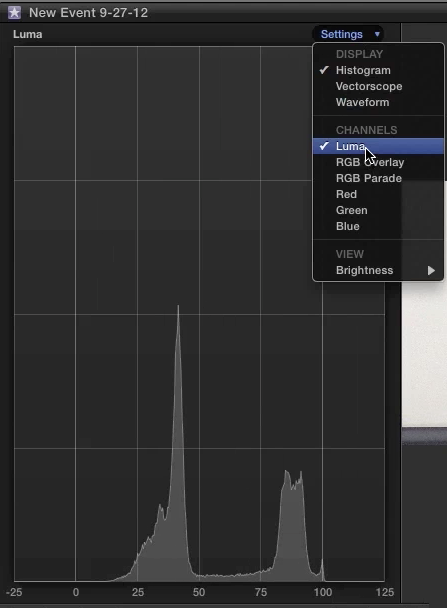
Specifically, the histogram shows the distribution of pixels according to brightness, from a scale of -25 to +125, with 0 as pure black, and 100 as pure white. The clumps you see in Figure 2 (above) show the groups of pixels at those brightness values.
In a well-lit, well-contrasted video with pure white and pure black regions, like this one, you'd want to see pixels at all brightness values from 0 to 100. In this video, we know we have issues because there's plenty of black in the frame (Figure 3, below), but the histogram shows us no pixels at the 0 IRE level (Figure 3, below), which is where the black pixels should sit. So, this tells us that the image lacks contrast.
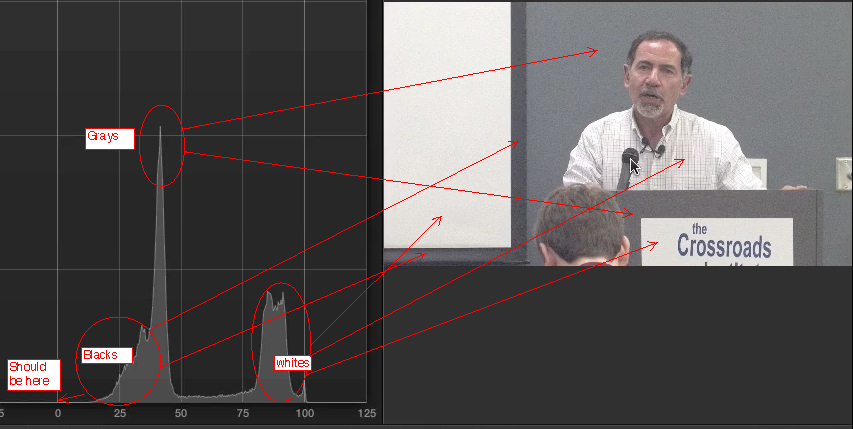
Figure 3 (above) shows the grays, blacks, and whites in the image, and where they appear in the histogram. Under optimal lighting, whites should be around 100 IRE; but most are clustered in the 80s. So, we see we have a problem with the brightness of the white pixels, as well as the blacks.
The third region you consider when adjusting contrast is the face, but the histogram really doesn't help us with that. When adjusting brightness in the face, it's best to work in the waveform monitor (Settings > Display > Waveform, as shown in Figure 4, below).
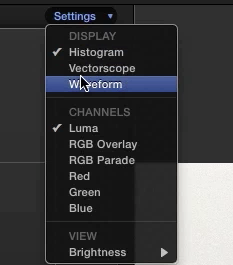
Working with the Waveform
The waveform shows you the same basic brightness information as the histogram, but presents pixels at their respective location in the frame. So, if you look at the pixels circled on the left in Figure 5 (below) you know they correspond to the whiteboard in the image. The pixels just to the right of them in the waveform correlate to the black line at the right edge of the whiteboard in the image. And the brownish pixels in the middle of the waveform are the candidate's face.
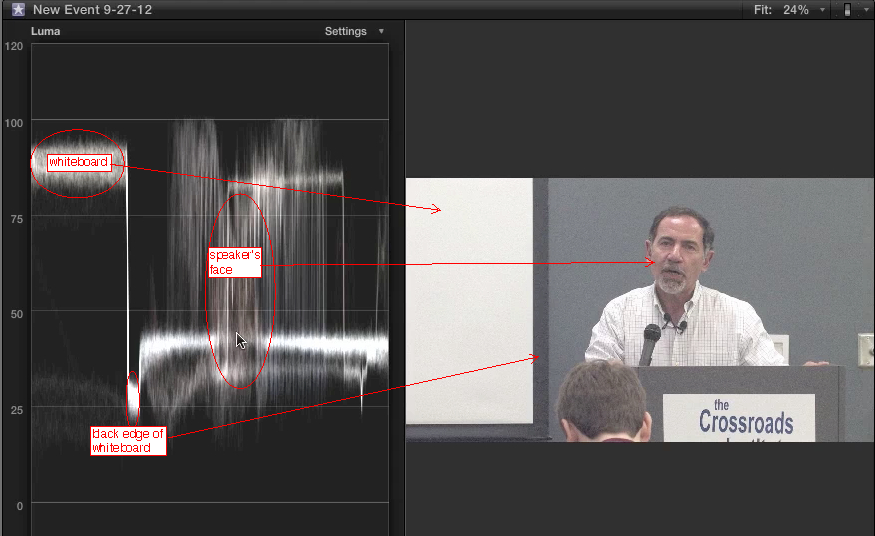
Now, typically when you're shooting with your zebra stripes, you want facial exposure at around 70-75 IRE at the brightest regions. In Figure 5 (above) you can see we're probably at around 60 IRE, so I want to boost that. Overall, when adjusting this video, I want these whites on the left (corresponding to the whiteboard) at 100, the blacks at 0, and the facial regions to be in the 70-75 range.
Related Articles
In this first installment of our new tutorial series, Glen Elliott demystifies Final Cut Pro X, illustrates its core functions, and focuses on one of the most powerful new features for organizing, accelerating, and streamlining your edits: metadata keyword tagging.
Background noise and pops and clicks in audio are an unfortunate fact of life for many productions. In this tutorial we'll explore some fixes you can try in Final Cut Pro X.
Jan Ozer sits down with Bill Roberts to discuss the trends impacting the future direction of Adobe Creative Suite for video pros, including the decline of 3D, the rise of 4K, and second-screen viewing. Other topics included the growth of Creative Cloud, and the development arc of Apple Final Cut Pro X.
In this tutorial, Jan Ozer demonstrates how you can use the Neat Video plug-in to remove noise from video, improving output quality for all outputs.
In this tutorial you'll learn how to maximize the brightness and contrast of your video in Adobe Premiere Pro CS6 using the Brightness, Contrast, and Gamma Correction controls for effective and balanced adjustments.
No matter how fast, efficient, and determined a 48 Hour Film Project production team is, they need to finish strong with a streamlined edit. Final.revised editor Scott Strimple describes how Apple Final Cut Pro X allowed him to deliver the goods on deadline, by leveraging key features that could make any edit cook.
When Apple originally released Final Cut Pro 10, the biggest deficit for Pro users was the lack of multicam. With the 10.0.3 release, Apple has addressed this with a highly functional and easy-to-use multicam feature, which Jan Ozer explains in this tutorial.